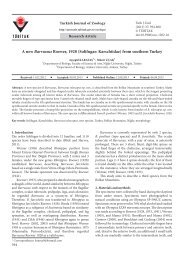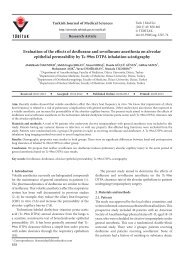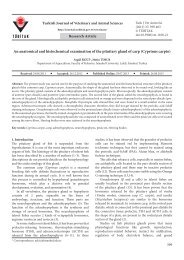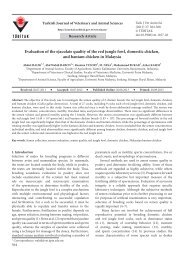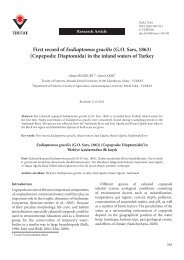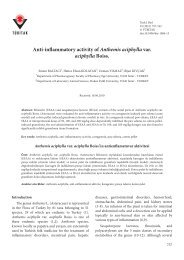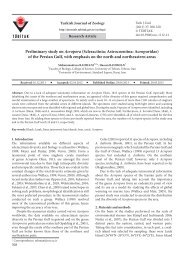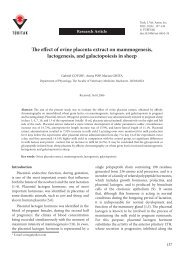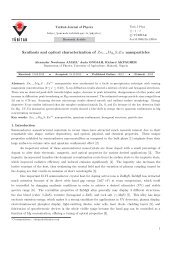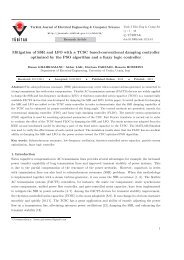Propagation of endangered Thermopsis turcica Kit Tan, Vural - Tübitak
Propagation of endangered Thermopsis turcica Kit Tan, Vural - Tübitak
Propagation of endangered Thermopsis turcica Kit Tan, Vural - Tübitak
You also want an ePaper? Increase the reach of your titles
YUMPU automatically turns print PDFs into web optimized ePapers that Google loves.
<strong>Propagation</strong> <strong>of</strong> <strong>endangered</strong> <strong>Thermopsis</strong> <strong>turcica</strong> <strong>Kit</strong> <strong>Tan</strong>, <strong>Vural</strong> &<br />
Küçüködük using conventional and in vitro techniques<br />
Süleyman CENKCİ, Mehmet TEMEL, Mustafa KARGIOĞLU, Sergun DAYAN<br />
Department <strong>of</strong> Biology, Faculty <strong>of</strong> Arts and Science, Afyon Kocatepe University, 03200, Afyonkarahisar - TURKEY<br />
Received: 03.11.2008<br />
Abstract: This report deals with the successful clonal propagation <strong>of</strong> <strong>endangered</strong> T. <strong>turcica</strong> using rhizome cuttings and<br />
epicotyl explants. Rhizome cuttings were treated with α-naphthaleneacetic acid (NAA) or indole-3-butyric acid (IBA)<br />
before planting for vegetative multiplication. Rhizome cuttings pretreated with NAA (10 mg/L) were both rooted and<br />
sprouted (66.6%) after 100 days. Application <strong>of</strong> NAA induced callus and adventitious root formation in epicotyl explants<br />
and 6-benzyladenine (BA) induced production <strong>of</strong> microshoots. Low levels <strong>of</strong> NAA (0.5-1 μM) together with BApromoted<br />
shoot initiation and development. The highest regeneration rate (86.6%), with a mean number <strong>of</strong> shoots (3.05) and a mean<br />
length <strong>of</strong> shoots (2.3 cm) per epicotyl, was achieved at 10 μM BA and 0.5 μM NAA. About 83% <strong>of</strong> in vitro regenerated<br />
shoots rooted on a ½ Murashige and Skoog (MS) medium supplemented with 0.3 μM NAA. In vitro plantlets were<br />
morphologically normal and a uniform chromosome complement <strong>of</strong> 2n = 18 was detected in root tips. The study<br />
demonstrated that both conventional and in vitro techniques could be useful for large scale multiplication and<br />
propagation <strong>of</strong> this <strong>endangered</strong> plant species.<br />
Key words: Conservation, rhizome cuttings, epicotyl, propagation, <strong>Thermopsis</strong> <strong>turcica</strong><br />
Tehlike altındaki <strong>Thermopsis</strong> <strong>turcica</strong>’nın <strong>Kit</strong> <strong>Tan</strong>, <strong>Vural</strong> & Küçüködük geleneksel ve<br />
in vitro teknikler kullanılarak çoğaltımı<br />
Özet: Bu rapor, tehlike altındaki T. <strong>turcica</strong>’nın rizom çelikleri ve epikotil eksplantları kullanılarak klonal çoğaltmasını<br />
kapsamaktadır. Rizom çelikler dikilmeden önce vejetatif çoğaltma için α-naftalenasetik asit (NAA) veya indol-3-butrik<br />
asit (IBA) ile ön muameleye tutulmuştur. NAA (10 mg/L) ile ön muamele edilmiş rizom çelikler 100 gün sonunda hem<br />
köklenmiş hem de filizlenmiştir (% 66,6). Epikotil eksplanlarında, NAA uygulaması kallus ve adventif kök oluşumunu<br />
ve 6-benziladenin (BA) uygulaması mikro-fide üretimini teşvik etmiştir. BA ile birlikte düşük NAA değerleri (0,5-1 μM)<br />
fidelenmeye uyarımı ve fide gelişimini arttırmıştır. En yüksek rejenerasyon oranı (% 86,6), explant başına ortalama fide<br />
sayısı (3,05) ve ortalama fide uzunluğu (2,3 cm) 10 μM BA ve 0,5 μM NAA ile başarılmıştır. In vitro rejenere fidelerin<br />
yaklaşık % 83’ü 0,3 μM NAA ile desteklenmiş ½ Murashige ve Skoog (MS) besininde köklenmiştir. In vitro bitkicikler<br />
morfolojik olarak normal ve kök uçlarındaki sabit kromozom sayısı 2n = 18 olarak tespit edilmiştir. Çalışma, hem<br />
geleneksel hem de in vitro tekniklerin tehlike altındaki bu bitki türünün seri üretilmesinde ve çoğaltılmasında kullanışlı<br />
olabileceğini göstermiştir.<br />
Anahtar sözcükler: Koruma, rizom çelik, epikotil, propagasyon, <strong>Thermopsis</strong> <strong>turcica</strong><br />
Introduction<br />
Fabaceae belongs to one <strong>of</strong> the largest families <strong>of</strong><br />
dicotyledons. It is a large, diverse family ranging from<br />
Turk J Biol<br />
33 (2009) 327-333<br />
© TÜBİTAK<br />
doi:10.3906/biy-0811-1<br />
herbaceous annuals to woody perennials that, because<br />
<strong>of</strong> their capacity to fix nitrogen, are essential<br />
components in natural and managed terrestrial<br />
327
<strong>Propagation</strong> <strong>of</strong> <strong>endangered</strong> <strong>Thermopsis</strong> <strong>turcica</strong> <strong>Kit</strong> <strong>Tan</strong>, <strong>Vural</strong> & Küçüködük using conventional and in vitro techniques<br />
ecosystems (1). <strong>Thermopsis</strong> <strong>turcica</strong> <strong>Kit</strong> <strong>Tan</strong>, <strong>Vural</strong> &<br />
Küçüködük is the sole endemic representative <strong>of</strong> the<br />
genus <strong>Thermopsis</strong> R. Br. in Turkey (2). The occurrence<br />
<strong>of</strong> 2-3 free carpellate-ovary is the main morphological<br />
character <strong>of</strong> this rare plant, first recorded in the<br />
Papilionoideae subfamily <strong>of</strong> Fabaceae (2,3). It spreads<br />
on the south shores <strong>of</strong> Eber Lake, and the south and<br />
south-west shores <strong>of</strong> Akşehir Lake, in west-central<br />
Anatolia. Destruction <strong>of</strong> marshy habitats by excessive<br />
drainage <strong>of</strong> lake water, causing consequent water<br />
withdrawals from Eber and Akşehir Lakes, and the<br />
utilization by the locals <strong>of</strong> the best habitats containing<br />
native vegetation are the major threats for the region<br />
(4). Therefore, almost all populations <strong>of</strong> T. <strong>turcica</strong> are<br />
in agricultural lands and under heavy destruction. In<br />
addition, it is not possible to obtain viable and<br />
germinable seeds from the plants growing in<br />
farmlands because unidentified seed predators<br />
(probably Coleoptera) utilize T. <strong>turcica</strong> seeds for larval<br />
development. Therefore, the major regeneration<br />
mode <strong>of</strong> this <strong>endangered</strong> species is through rhizomes.<br />
One <strong>of</strong> the most appropriate actions for<br />
safeguarding over-exploited species is to improve<br />
propagation techniques and to encourage cultivation<br />
(5). Seeds are preferred to vegetative material as the<br />
source <strong>of</strong> propagation material because a wider<br />
genetic base can be maintained (6). However, in some<br />
species such as Delphinium malabaricum (7),<br />
Rauvolfia micrantha (8), and <strong>Thermopsis</strong> <strong>turcica</strong> (9)<br />
seed is not readily available and therefore vegetative<br />
material has to be used (5,6). Although in vitro<br />
preservation methods have been traditionally used for<br />
crop species, these techniques have also been<br />
increasingly used in the conservation <strong>of</strong> rare or<br />
<strong>endangered</strong> plants in recent years, and this trend is<br />
likely to continue as more species face the risk <strong>of</strong><br />
extinction (10). In vitro multiplications <strong>of</strong> some<br />
threatened plant species native to Turkey, e.g.<br />
Anthemis xylopoda O.Schwarz (11), Sternbergia<br />
fisheriana (Herbert) Rupr. (12), and Centaurea<br />
tchihatcheffii Fisch. et Mey. (13) have been reported.<br />
This work is part <strong>of</strong> a project that aims at the<br />
propagation and in vitro conservation <strong>of</strong> <strong>endangered</strong><br />
T. <strong>turcica</strong>. The present investigation was conducted to<br />
achieve vegetative propagation using rhizome<br />
cuttings, and to develop an effective in vitro<br />
propagation protocol using epicotyl segments <strong>of</strong> T.<br />
<strong>turcica</strong>. Cytological analyses were also performed to<br />
328<br />
determine number <strong>of</strong> chromosomes and to check the<br />
clonal fidelity <strong>of</strong> regenerants.<br />
Materials and methods<br />
Plant material<br />
Mature pods containing viable and germinable<br />
seeds were collected from a small (less than 50<br />
individuals) and isolated (naturally protected against<br />
pest infestation) T. <strong>turcica</strong> population near Eber Lake<br />
(38°36´N, 31°14´E) in September 2005 and 2006.<br />
Rhizomes obtained from a widespread Akşehir<br />
population were brought to the laboratory in plastic<br />
bags and used immediately for vegetative propagation<br />
studies.<br />
Rhizome propagation<br />
Rhizomes were cut into small segments <strong>of</strong> 4-5 cm<br />
in length (with 2-3 nodes) and treated with auxins (24<br />
h, dark) by dipping the basal portion (1-1.5 cm) <strong>of</strong><br />
rhizome cuttings in treatment solutions kept in<br />
separate glass beakers. The auxin treatments<br />
contained IBA or NAA (10, 100, and 250 mg L -1 ).<br />
Subsequently, the control (treated with water) and<br />
treated rhizome cuttings were planted in an open field<br />
(50 × 300 cm) enriched with farmyard manure on the<br />
Campus <strong>of</strong> Afyon Kocatepe University (38°49´N,<br />
30°32´E; 1000 m altitude). Each treatment consisted<br />
<strong>of</strong> 8 rhizome cuttings, each with 3 replicates. After 100<br />
days, the rhizome cuttings were carefully removed<br />
from the soil, and rooting/sprouting data were<br />
recorded.<br />
In vitro propagation<br />
Hard-coated T. <strong>turcica</strong> seeds were both scarified<br />
and sterilized by immersing them into concentrated<br />
H2SO4 for 90 min, and subsequently rinsed 6 times<br />
with sterile and distilled water. Scarified and sterilized<br />
seeds were then sown on solid agar for germination.<br />
Epicotyls dissected from 15-day-old seedlings were<br />
cut into 7-10 mm long segments and placed on a<br />
medium consisting <strong>of</strong> salts and vitamins <strong>of</strong> MS (14)<br />
and 3% sucrose. Plant growth regulators were<br />
incorporated into the medium at varying<br />
concentrations and combinations. The pH <strong>of</strong> the<br />
medium was adjusted to 5.8 ± 0.1 before adding 0.7%<br />
agar and autoclaved at 1.5 kg cm -2 and 121 °C for 15<br />
min. Thirty epicotyl explants were cultured for each <strong>of</strong><br />
the 20 treatments on the MS solid medium
supplemented with 0, 1, 2, 5, and 10 μM <strong>of</strong> BA in<br />
combination with 0, 0.5, 1, and 2 μM <strong>of</strong> NAA. The<br />
cultures were started in sterile Petri dishes, and they<br />
were then, after 3 weeks, transferred into in vitro vent<br />
culture boxes (DUCHEFA, Netherlands) containing<br />
the same medium composition. The percentage <strong>of</strong><br />
shoot formation, the mean number and length <strong>of</strong><br />
shoots per epicotyl explant were recorded after 6<br />
weeks <strong>of</strong> culture. All the cultures were grown at 25 ±<br />
1 °C under 16 h photoperiods with an irradiance <strong>of</strong><br />
75 μmol m -2 s -1 and using Grolux fluorescent tubes<br />
(Sylvania).<br />
In vitro rooting<br />
In vitro differentiated shoots (1-5 cm long) were<br />
excised and transferred to ½ MS medium<br />
supplemented with various concentrations (0, 0.1, 0.3,<br />
0.5, and 1 μM) <strong>of</strong> NAA. Twenty regenerates were used<br />
in each trail and each experiment was repeated at least<br />
twice. Data were collected 35 days after culture.<br />
Acclimatization<br />
In vitro raised plantlets were removed from culture<br />
tubes and their roots washed under running tap water.<br />
They were then transferred to cups containing<br />
autoclaved vermiculite mixed with sterile garden soil<br />
using a ratio <strong>of</strong> 1:1. The cups were kept in a mist<br />
chamber for hardening at 80%-90% relative humidity<br />
for 4 weeks. The regenerates were finally transferred<br />
to greenhouse conditions and watered with tap water.<br />
S. CENKCİ, M. TEMEL, M. KARGIOĞLU, S. DAYAN<br />
Cytological analysis<br />
For chromosome counts, root tips obtained from<br />
in vitro plantlets were incubated at 0 °C for 16 h in<br />
saturated α-bromonaphthalene, fixed in glacial acetic<br />
acid for 30 min, stained by the aceto-orcein reaction,<br />
and squashed with 45% acetic acid on a microscope<br />
slide for examination using a light microscope at 100×<br />
magnifications.<br />
Statistical analysis<br />
The effect <strong>of</strong> different treatments was quantified<br />
and the data were analyzed using one-way analysis <strong>of</strong><br />
variance (ANOVA). The means were compared using<br />
Duncan’s test at a P < 0.05 significance level.<br />
Results and discussion<br />
Rhizome propagation<br />
In general, root and sprout formation occurred in<br />
the rhizome cuttings within 100 days, irrespective <strong>of</strong><br />
the treatment regime. Table 1 summarizes the effect <strong>of</strong><br />
IBA and NAA on the rooting and sprouting <strong>of</strong> the<br />
rhizome cuttings. Among the various treatments, 250<br />
mg L -1 IBA or 10 mg L -1 NAA induced rooting<br />
significantly more than the water treated group. The<br />
IBA treatment (250 mg L -1 ) on cuttings resulted in the<br />
highest rooting rate (83.3%), a mean root number <strong>of</strong><br />
3.2, and a mean root length <strong>of</strong> 4.2 cm after 100 days;<br />
however, this treatment did not promote sprouting<br />
Table 1. Effect <strong>of</strong> IBA and NAA on rooting and sprouting <strong>of</strong> rhizome cuttings <strong>of</strong> T. <strong>turcica</strong>.<br />
Treatment Percentage <strong>of</strong> Percentage <strong>of</strong> Mean number Mean root<br />
(mg L -1 ) rooting rooting and sprouting <strong>of</strong> roots length (cm)<br />
Control 16.6 a<br />
IBA<br />
10 50.0 ab<br />
100 58.3 ab<br />
250 83.3 b<br />
NAA<br />
10 75.0 b<br />
100 58.3 ab<br />
250 58.3 ab<br />
16.6 a<br />
33.3 ab<br />
41.6 ab<br />
8.3 a<br />
66.6 b<br />
25.0 a<br />
16.6 a<br />
0.33 a<br />
1.08 a<br />
2.83 bc<br />
3.25 c<br />
1.42 ab<br />
0.75 a<br />
1.17 a<br />
0.56 a<br />
0.73 ab<br />
2.23 abc<br />
4.22 c<br />
2.70 bc<br />
2.39 abc<br />
2.35 abc<br />
Data were recorded after 100 days <strong>of</strong> planting; n = 24; Means within each column followed by the same superscripts are not significantly<br />
different according to Duncan’s test at 0.05% probability level.<br />
329
<strong>Propagation</strong> <strong>of</strong> <strong>endangered</strong> <strong>Thermopsis</strong> <strong>turcica</strong> <strong>Kit</strong> <strong>Tan</strong>, <strong>Vural</strong> & Küçüködük using conventional and in vitro techniques<br />
(8.3%) (Figure 1a) compared to the water treated<br />
group (25%). In contrast, a treatment <strong>of</strong> 10 mg L -1<br />
NAA on the cuttings resulted in the highest sprouting<br />
and rooting ratio (66.6%) (Figure 1b). Vegetative<br />
propagation via rhizome cuttings has also been<br />
reported to be effective in the multiplication <strong>of</strong><br />
330<br />
a b c<br />
d e f<br />
g h i<br />
<strong>endangered</strong> plant species, such as Aconitum atrox<br />
(Bruhl) Muk. (15), Picrorhiza kurrooa Royle ex Benth.<br />
(16), and Podophyllum hexandrum Royle (17). In this<br />
study, propagation through rhizome cuttings was<br />
found to be quite successful with 10 mg L -1 NAA. Seed<br />
availability, seed germination, and seedling survival<br />
Figure 1. Conventional and in vitro propagation in T. <strong>turcica</strong>. (a) Rooted rhizome cuttings at 100 days after the 250 mg L -1 IBA<br />
pretreatment. (b) Rooted and sprouted rhizome cuttings at 100 days after the 10 mg L -1 NAA. (c) Callus induction in epicotyl<br />
explants with 0.5 μM NAA. (d) Simultaneous root development in an epicotyl explant with 2 μM NAA. Induction (e) and<br />
development (f) <strong>of</strong> in vitro shoots with 10 μM BA and 0.5 μM NAA after 2 and 6 weeks <strong>of</strong> culture. (g) Rooted in vitro raised<br />
shoots on ½ MS medium supplemented with 0.3 mg L -1 NAA after 5 weeks <strong>of</strong> culture. (h) Six-week-old in vitro raised plantlets.<br />
(i) A chromosome complement <strong>of</strong> 2n = 18 from the root-tip cell <strong>of</strong> a regenerated plant; the bar represents 10 μm.
problems for T. <strong>turcica</strong> had been reported previously<br />
(9). Therefore, raising the crop through rhizome<br />
cuttings is an additional method <strong>of</strong> obtaining plantlets<br />
and is advantageous because it eliminates some <strong>of</strong> the<br />
difficulties with seed germination and seedling<br />
survival. Nadeem et al. (17) suggested that<br />
propagation through rhizome cuttings would also<br />
reduce the length <strong>of</strong> the cultivation cycle and being a<br />
clonal method <strong>of</strong> propagation should avoid variation<br />
found in the seedling populations.<br />
In vitro propagation<br />
Legumes are notoriously recalcitrant to tissue<br />
culture and are difficult to regenerate in vitro (18).<br />
However, during the last decade, it has been achieved<br />
with different kinds <strong>of</strong> legumes such as Astragalus<br />
condensatus Ledeb (19), Vigna mungo (20), Phaseolus<br />
vulgaris, P. acutifolius (21), and Cajanus cajan (22).<br />
Successful regeneration <strong>of</strong> legumes has been aided by<br />
S. CENKCİ, M. TEMEL, M. KARGIOĞLU, S. DAYAN<br />
species specific determination <strong>of</strong> critical regeneration<br />
parameters such as explant source, genotype, and<br />
media constituents (18,23).<br />
No morphogenetic response was observed when<br />
epicotyl explants were cultured on the MS basal<br />
medium alone. On the medium with NAA alone, only<br />
callus (Figure 1c) or simultaneous roots were formed<br />
(Table 2, Figure 1d). In general, callusing and<br />
simultaneous root formation were also observed in<br />
the MS medium supplemented with high levels <strong>of</strong><br />
NAA and low levels <strong>of</strong> BA. Shoot induction was<br />
observed from the cut ends <strong>of</strong> epicotyl explants after<br />
2 weeks in the culture (Figure 1e). BA alone induced<br />
a large frequency <strong>of</strong> shoots, but high levels <strong>of</strong> BA and<br />
low levels <strong>of</strong> NAA were more effective. The optimum<br />
concentrations <strong>of</strong> BA and NAA were 10 μM and 0.5<br />
μM, respectively, at which 86.6% <strong>of</strong> explants<br />
responded; the number <strong>of</strong> shoots per explant was 3.05<br />
Table 2. Effects <strong>of</strong> BA/NAA combinations in MS medium on morphogenetic responses from epicotyl explants <strong>of</strong> T. <strong>turcica</strong> after 8<br />
weeks <strong>of</strong> culture.<br />
BA NAA Morphogenetic Percentage <strong>of</strong> Mean number Mean length<br />
(μM) (μM) response †<br />
shooting <strong>of</strong> shoots <strong>of</strong> shoots (cm)<br />
0.0 0.0 - 0.0 a<br />
0.0 0.5 c;sr 0.0 a<br />
0.0 1.0 c;sr 0.0 a<br />
0.0 2.0 c;sr 0.0 a<br />
1.0 0.0 s 26.6 ab<br />
1.0 0.5 s 33.3 ab<br />
1.0 1.0 c;sr;s 26.6 ab<br />
1.0 2.0 c;sr;s 26.6 ab<br />
2.0 0.0 s 40.0 abc<br />
2.0 0.5 s 50.0 bcd<br />
2.0 1.0 c;sr;s 46.6 bcd<br />
2.0 2.0 c;sr;s 46.6 bcd<br />
5.0 0.0 s 60.0 bcd<br />
5.0 0.5 s 76.6 cd<br />
5.0 1.0 c;s 66.6 bcd<br />
5.0 2.0 c;s 60.0 bcd<br />
10.0 0.0 s 60.0 bcd<br />
10.0 0.5 s 86.6 d<br />
10.0 1.0 s 66.6 bcd<br />
10.0 2.0 c;s 56.6 bcd<br />
0.0 a<br />
0.0 a<br />
0.0 a<br />
0.0 a<br />
0.26 ab<br />
0.53 abc<br />
0.41 abc<br />
0.29 ab<br />
0.56 abc<br />
1.30 cd<br />
1.20 cd<br />
1.21 cd<br />
2.20 ef<br />
2.61 f<br />
1.73 de<br />
1.53 de<br />
0.90 abcd<br />
3.05 f<br />
1.16 bcd<br />
1.12 bcd<br />
0.0 a<br />
0.0 a<br />
0.0 a<br />
0.0 a<br />
0.88 ab<br />
1.75 ab<br />
1.77 ab<br />
1.86 ab<br />
1.88 ab<br />
2.07 ab<br />
1.71 ab<br />
1.85 ab<br />
1.26 ab<br />
1.91 ab<br />
1.10 abc<br />
1.31 ab<br />
1.68 ab<br />
2.30 c<br />
2.13 c<br />
1.61 ab<br />
(†)c, callusing; sr, simultaneous rooting; s, shooting. Means within each column followed by the same superscripts are not significantly<br />
different according to Duncan’s test at 0.05% probability level.<br />
331
<strong>Propagation</strong> <strong>of</strong> <strong>endangered</strong> <strong>Thermopsis</strong> <strong>turcica</strong> <strong>Kit</strong> <strong>Tan</strong>, <strong>Vural</strong> & Küçüködük using conventional and in vitro techniques<br />
and the mean length <strong>of</strong> shoots per explant was 2.3 cm<br />
(Figure 1f). Similar micropropagation values were<br />
reported for BA plus NAA treated epicotyl explants <strong>of</strong><br />
some legumes such as Vigna mungo L. (20) and<br />
Lathyrus sativus L. (24). On the other hand, a very low<br />
regeneration rate (< 29%) via indirect organogenesis<br />
from calli initiated from the epicotyl explants <strong>of</strong><br />
Macroptilium atropurpureum (DC.) Urb. (Fabaceae)<br />
(25) was observed after cytokinin/auxin treatments.<br />
The results indicated that the morphogenetic<br />
response <strong>of</strong> epicotyl explants was determined by the<br />
amounts <strong>of</strong> plant growth regulators used in the study.<br />
NAA alone promoted callusing or simultaneous<br />
rooting; such a situation was also reported for<br />
Rudbeckia bicolor Nutt. (26) and <strong>Thermopsis</strong><br />
lupinoides L. (27). BA is considered one <strong>of</strong> the most<br />
useful cytokinins for achieving the multiplication and<br />
micropropagation <strong>of</strong> plants (28). However, in the<br />
present study with T. <strong>turcica</strong>, an optimized<br />
combination <strong>of</strong> NAA with BA gave the best response.<br />
Existing reports suggest that NAA at low<br />
concentrations along with BA have a critical role in<br />
plant regeneration for some leguminous plants, such<br />
as Acacia catechu Willd. (29), Clitoria ternatea L. (30),<br />
Mucuna pruriens L. (31), Psoralea corylifolia (L.)<br />
Medik. (32), and Vigna mungo L. (20).<br />
There was no visible root induction until 5 weeks<br />
after transfer to hormone free ½ MS medium. A high<br />
frequency <strong>of</strong> rooting was induced on ½ MS medium<br />
supplemented with 0.1-1.0 μM NAA (Table 3, Figure<br />
1g). The maximum frequency <strong>of</strong> root formation was<br />
achieved on ½ MS medium supplemented with 0.3<br />
μM NAA. The success <strong>of</strong> NAA for efficient root<br />
induction was also reported in Clitoria ternatea (30)<br />
332<br />
and Cercis canadensis var. mexicana (33). In vitro<br />
raised plantlets were subsequently transferred to<br />
plastic cups filled with sterile vermiculate and garden<br />
soil, and then successfully acclimatized (80%) in a<br />
mist house (Figure 1h). None <strong>of</strong> these plantlets<br />
showed any phenotypic variation when compared<br />
with the mother plant after 10 months. Root tip<br />
squashes <strong>of</strong> the randomly selected micropropagated<br />
plants revealed a uniform chromosome complement<br />
<strong>of</strong> 2n = 18 (Figure 1i). The diploid chromosome<br />
numbers found for T. <strong>turcica</strong> are similar to other<br />
species <strong>of</strong> <strong>Thermopsis</strong> R.Br. (3,34). Chromosomal<br />
analyses showed that the regenerates were<br />
cytologically stable.<br />
Conclusion<br />
In this study, it has been shown that rhizome<br />
cuttings and epicotyl explants can be successfully used<br />
to propagate <strong>endangered</strong> T. <strong>turcica</strong>. Endangered plants<br />
can be regenerated in a short span <strong>of</strong> time (< a year)<br />
using both conventional and in vitro procedures; the<br />
mother plant can be conserved too. The efficient plant<br />
regeneration system developed in this study will be<br />
useful for the ex situ conservation <strong>of</strong> T. <strong>turcica</strong>.<br />
Corresponding Author:<br />
Süleyman CENKCİ<br />
Department <strong>of</strong> Biology,<br />
Afyon Kocatepe University, ANS Campus, 03200,<br />
Afyonkarahisar – TURKEY<br />
E-mail: scenkci@aku.edu.tr<br />
Table 3. Effects <strong>of</strong> ½ MS medium supplemented with different concentrations <strong>of</strong> NAA on root induction in the shoots regenerated<br />
from epicotyl explants <strong>of</strong> T. <strong>turcica</strong> after 35 days <strong>of</strong> culture.<br />
NAA (μM) Rooting percentage Number <strong>of</strong> roots Root length (cm)<br />
0.0 0.0 a<br />
0.1 67.5 ± 7.5 bc<br />
0.3 82.5 ± 6.1 c<br />
0.5 77.5 ± 6.5 bc<br />
0.7 52.5 ± 7.9 b<br />
1.0 17.5 ± 6.8 a<br />
0.0 a<br />
2.5 ± 0.27 de<br />
2.72 ± 0.30 e<br />
1.45 ± 0.26 cd<br />
1.18 ± 0.19 bc<br />
0.50 ± 0.19 ab<br />
0.0 a<br />
2.37 ± 0.38 c<br />
4.27 ± 0.49 d<br />
2.48 ± 0.35 c<br />
1.83 ± 0.33 bc<br />
0.62 ± 0.23 ab<br />
Means (±SE) within each column followed by the same superscripts are not significantly different according to Duncan’s test at 0.05%<br />
probability level.
References<br />
1. Somers DA, Samac DA, Olh<strong>of</strong>t PM. Recent advances in legume<br />
transformation. Plant Physiol 131: 892-899, 2003.<br />
2. <strong>Tan</strong> K, <strong>Vural</strong> M, Küçüködük M. An unusual new <strong>Thermopsis</strong><br />
from Turkey. Notes RBG Edinb 40: 515-518, 1983.<br />
3. Davis PH, Mill RR, <strong>Kit</strong> T. Flora <strong>of</strong> Turkey and the East Aegean<br />
Islands. Vol. 10, Edinburgh University Press; 1988; pp. 111-112.<br />
4. <strong>Tan</strong> A, Duman H, Niksarlı İF et al. Ecosystem conservation and<br />
management for threatened species projects: description <strong>of</strong><br />
target species and their habitats TACN (Turkish Association for<br />
the Conservation <strong>of</strong> Nature), Ankara, 2003.<br />
5. Pence VC. The application <strong>of</strong> biotechnology for the<br />
conservation <strong>of</strong> <strong>endangered</strong> plant species. In: Benson EE. ed.<br />
Plant Conservation Biotechnology. Taylor and Francis; 1999:<br />
pp. 227-242.<br />
6. Fay MF. Conservation <strong>of</strong> rare and <strong>endangered</strong> plants using in<br />
vitro methods. In Vitro Cell Dev Biol Plant 28: 1-4, 1992.<br />
7. Agrawal DC, Pawar SS, Morwal GC et al. In vitro<br />
8.<br />
micropropagation <strong>of</strong> Delphinium malabaricum (Huth) Munz.-<br />
A rare species. Ann Bot 68: 243-245, 1991.<br />
Sudha CG, Seeni S. In vitro propagation <strong>of</strong> Rauvolfia micrantha,<br />
a rare medicinal plant. Plant Cell Tissue Organ Cult 44: 243-<br />
248, 1996.<br />
9. Cenkci S, Kargıoğlu M, Dayan S et al. Endangered status and<br />
propagation <strong>of</strong> an endemic plant species, <strong>Thermopsis</strong> <strong>turcica</strong><br />
(Fabaceae). Asian J Plant Sci 6: 288-293, 2007.<br />
10. Sarasan V, Cripps R, Ramsay MM et al. Conservation in vitro <strong>of</strong><br />
threatened plants – Progress in the past decade. In Vitro Cell<br />
Dev Biol Plant 42: 206-214, 2006.<br />
11. Erdağ B, Emek Y. In vitro micropropagation <strong>of</strong> Anthemis<br />
xylopoda O. Schwarz, a critically <strong>endangered</strong> species from<br />
Turkey. Pak J Biol Sci 8: 691-695, 2005.<br />
12. Mirici S, Parmaksız İ, Özcan S et al. Efficient in vitro bulblet<br />
regeneration from immature embryos <strong>of</strong> <strong>endangered</strong><br />
13.<br />
Sternbergia fisheriana. Plant Cell Tissue Organ Cult 80: 239-<br />
246, 2005.<br />
Özel CA, Khawar KM, Mirici S et al. Factors affecting in vitro<br />
plant regeneration <strong>of</strong> the critically <strong>endangered</strong> Mediterranean<br />
knapweed (Centaurea tchihatcheffii Fisch. et Mey.).<br />
14.<br />
Naturwissenschaften 93: 511-517, 2006.<br />
Murashige T, Skoog F. A revised medium for rapid growth and<br />
bioassays with tobacco tissue culture. Physiol Plantarum 15:<br />
473-497, 1962.<br />
15. Rawat AS, Pharswan AS, Nautiyal MC. <strong>Propagation</strong> <strong>of</strong><br />
Aconitum atrox (Bruhl) Muk. (Ranunculaceae), a regionally<br />
threatened medicinal herb. Econ Bot 46: 337-338, 1992.<br />
16. Chandra B, Palni LMS, Nandi SK. <strong>Propagation</strong> and<br />
conservation <strong>of</strong> Picrorhiza kurrooa Royle ex Benth.: An<br />
<strong>endangered</strong> Himalayan medicinal herb <strong>of</strong> high commercial<br />
value. Biodivers Conserv 15: 2325-2338, 2006.<br />
17. Nadeem M, Palni LMS, Purohit AN et al. <strong>Propagation</strong> and<br />
conservation <strong>of</strong> Podophyllum hexandrum Royle: an important<br />
medicinal herb. Biol Conserv 92: 121-129, 2000.<br />
S. CENKCİ, M. TEMEL, M. KARGIOĞLU, S. DAYAN<br />
18. Khawar KM, Özcan S. Effect <strong>of</strong> indole-3-butyric acid on in vitro<br />
root development in lentil (Lens culinaris Medik.). Turk J Bot<br />
26: 109-111, 2002.<br />
19. Erdağ B. A note on in vitro seed germination and shoot<br />
multiplication <strong>of</strong> Astragalus condensatus Ledeb., an endemic <strong>of</strong><br />
Turkish flora. Bio-Science Research Bulletin 18: 93-97, 2002.<br />
20. Agnihotri S, Singh RR, Chaturvedi HC. In vitro high frequency<br />
regeneration <strong>of</strong> plantlets <strong>of</strong> Vigna mungo and their ex vitro<br />
growth. Indian J Exp Biol 39: 916-20, 2001.<br />
21. Zambre MA, De Clercq J, Vranova E et al. Plant regeneration<br />
from embryo-derived callus in Phaseolus vulgaris L. (common<br />
bean) and P. acutifolius A. Gray (tepary bean). Plant Cell Rep<br />
17: 626-630, 1998.<br />
22. Kumar AS, Reddy TP, Reddy GM. Plantlet regeneration from<br />
different callus cultures <strong>of</strong> pigeonpea (Cajanus cajan L.). Plant<br />
Sci Lett 32: 271-278, 1983.<br />
23. Parrott WA, Williams EG, Hildebrand DF et al. Effect <strong>of</strong><br />
genotype on somatic embryogenesis from immature cotyledons<br />
<strong>of</strong> soybean. Plant Cell Tissue Organ Cult 16: 15-21, 1988.<br />
24. Barik DP, Mohapatra U, Chand PK. High frequency in vitro<br />
regeneration <strong>of</strong> Lathyrus sativus L. Biol Plant 49: 637-639, 2005.<br />
25. Ezura H, Nukui N, Yuhashi K-I et al. In vitro plant regeneration<br />
in Macroptilium Atropurpureum, a legume with a broad<br />
symbiont range for nodulation. Plant Sci 159: 21-27, 2000.<br />
26. <strong>Tan</strong>imoto S, Harada H. Physiological and hormonal factors<br />
influencing organogenesis in Rudbeckia bicolor explants<br />
cultured in vitro. Plant Cell Physiol 23: 107-113, 1982.<br />
27. Saito K, Yamazaki M, Takamatsu S et al. Greening induced<br />
production <strong>of</strong> (+)-lupanine in tissue culture <strong>of</strong> <strong>Thermopsis</strong><br />
lupinoides. Phytochemistry 28: 2341-2344, 1989.<br />
28. Stfaan P, Werbrouck O, Debergh PC. Applied aspects <strong>of</strong> plant<br />
regeneration. In: Dixon RA, Gonzales RA eds. Plant cell culture:<br />
A practical approach. Oxford University Press; 1994; pp. 127-<br />
145.<br />
29. Kaur K, Verma B, Kant U. Plants obtained from the Khair tree<br />
(Acacia catechu Willd.) using mature nodal segments. Plant Cell<br />
Rep 17: 427-429, 2004.<br />
30. Rout GR. Micropropagation <strong>of</strong> Clitoria ternatea Linn.<br />
31.<br />
(Fabaceae) - An important medicinal plant. In Vitro Cell Dev<br />
Biol Plant 41: 516-519, 2005.<br />
Faisal M, Siddque I, Anis M. An efficient plant regeneration<br />
system for Mucuna pruriens L. (DC.) using cotyledonary node<br />
explants. In Vitro Cell Dev Biol Plant 42: 56-64, 2006.<br />
32. Saxena C, Palai SK, Samantaray S et al. Plant regeneration from<br />
callus cultures <strong>of</strong> Psoralea corylifolia Linn. Plant Growth Regul<br />
22: 13-17, 2004.<br />
33. Mackay WA, Tipton JL, Thompson GA. Micropropagation <strong>of</strong><br />
Mexican redbud, Cercis canadensis var. mexicana. Plant Cell<br />
Tissue Organ Cult 43: 295-299, 1995.<br />
34. Chen CJ, Mendenhall MG, Turner BL. Taxonomy <strong>of</strong> <strong>Thermopsis</strong><br />
(Fabaceae) in North America. Ann Missouri Bot Gard 81: 714-<br />
745, 1994.<br />
333



